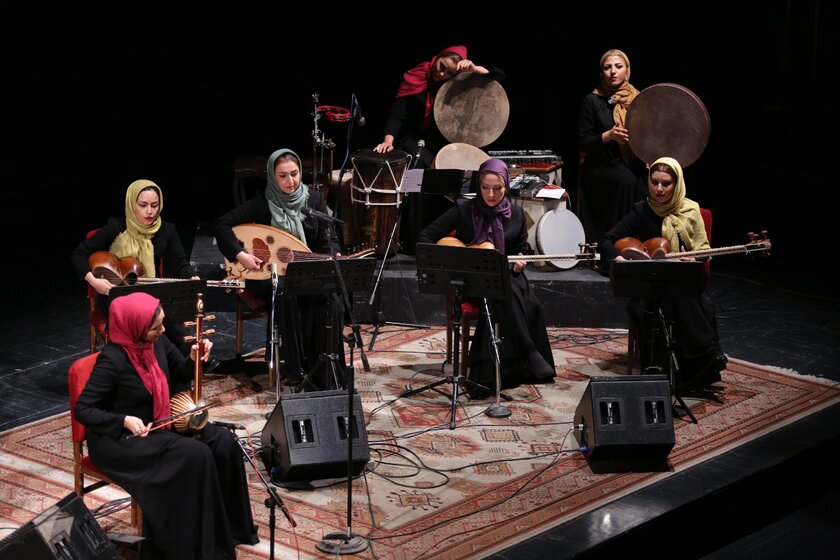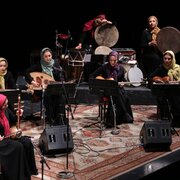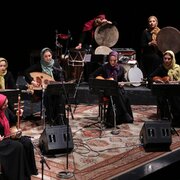
Songs
- country:Iran
- region:Middle East
- style(s):Folk, Persian
- label:Pardis Records
- type:Band
- gender:female
- instrumentation:instrumental
- artist posted by:Pardis Records
Line up
- Asal Malekzadeh (Daf)
- Bahareh Heydari (Tar)
- Behzad Abdi (Conductor & Composer)
- Hila Feizpour (Tar)
- Mehrnam Rastegari (Kamancheh)
- Mehrnaz Dabirzadeh (Percussion)
- Nazanin Roosta (Qeychak Bass)
- Negin Zadehvakili (Qeychak)
- Rokhsareh Rostami (Oud)
- Samaneh Barooti (Qeychak Alto)
- Seda Sodeyfi (Qanoon)
- Sheyda Ghazi (Reed)
- Targol Khalighi (Rubab)
Women’s voice is not just restricted to singing; Now, though their larynxes have been sentenced to silence for years in command of religion, seeing their brilliant achievements in instrumental performance is very pleasing and promising. Perhaps, when Behzad Abdi first intended to form Khonyāgarān ensemble, he aimed to present a different orchestration for Iranian instruments based on the classical orchestration. However, he wisely recognized that the discipline, perseverance, patience and motivation found in women musicians would lead him to a desirable upshot more swiftly. The glorious companionship he managed -comprising twelve female players and a male singer- gained a symbolic function as a result of socio-historical reasons; Specially that “Being a Musician” (Khonyāgari in Persian) originally referred to playing and singing together with story-telling, a tradition that was in its heyday during Parthian empire. But, in Sassanid era, Zoroastrian and even Manichean priests started to oppose it. So, what can we say while the subject of our story bears a hundreds-year-old silence, having faced ups and downs in both pre-Islamic and Islamic periods (let alone those before and after the Islamic revolution); we can just write “Khonyāgarān-Mehr” (musicians of love and passion) and call them the raconteurs of the sound of silence. Behzad Abdi is an adroit composer and orchestrator, with so many great works of film music in his resume. Yet, his other art is to turn the constraints to possibilities.
We hope that the persistence of Khonyāgarān-Mehr ensemble’s activities promotes their technical performance skills, fosters their creativity and bestows expert women composers and arrangers upon Iranian music society. We hope to witness the emergence of artists whose works reflect signs of feminine mentality and add a feminine facet to what is called “the masculine history of aesthetics” in the “feminist aesthetics” or “feminist musicology”; the facet that has been always suppressed over time and never gained the chance to manifest.
Women, today, are expected to take stronger steps, do not be afraid of judgments, adorn their art with their feminine features so that their artworks represent them in the boldest manner, and eventually, do not obey what is asked from them to be or to become. Well! If you have called for the moon, you have to be the sky first! Let us recite with the great Persian musician and poet Rudaki, the poem he wrote in the 4th A.H:
The moon’s the prince, Bukhara is the sky;
O Sky, the Moon shall light thee by and by!



